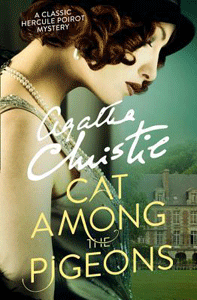A school is a great place for a moody mystery. I’ve been drawn to this combination through the years, from “Buffy” and “Veronica Mars” episodes to “Harry Potter” books. Agatha Christie didn’t use this tasty pairing of genre and location a lot, but she does in the Poirot novel “Cat Among the Pigeons” (1959), and that’s a big reason why I like it.
Murder 101
The cat is not Poirot himself, although Christie had described him as being like a sly feline with twinkling green eyes in past novels. In “Death on the Nile,” he pounces like a cat at one point. Rather, this is one of those novels where Poirot appears late in the game – on page 159 out of 224 – to sort everything out for us.
The “cat among the pigeons” is the killer among the students and teachers at a girls’ school called Meadowbank. Christie gives us lots of words about how Miss Bulstrode built the school up. Although nicknamed “Bully,” she is universally admired for her dedication to maintaining a great learning environment.

“Cat Among the Pigeons” (1959)
Author: Agatha Christie
Genre: Mystery
Series: Hercule Poirot No. 29
Setting: Meadowbank school, England, 1959
I would’ve liked more details about Bulstrode’s educational philosophy, and how private schools fit into the English governmental scheme at the time. I get the impression that Meadowbank is an old-fashioned “finishing school” (one that turns children into ladies of proper comportment). Yet it’s not stuffy, and Bulstrode’s (unfortunately ill-defined) forward-thinking ideas are what has made it a success.
As a tennis fan, I enjoyed coming across pals Jennifer and Julia, who work on their games on the impressive grounds. Near the court is an indoor Sports Pavilion that ends up hosting more murders than athletic activities. The killings are discovered by flashlight in the middle of the night, appropriately calling to mind a reader’s earliest brush with creepy crimes, perhaps via “The Hardy Boys” or “Nancy Drew.”
Although I didn’t predict whodunit, I did correctly predict how the girls’ swapping of tennis rackets would come into play. It’s nice of Christie to give me a chance at that small victory.
Roll call
Christie lightly dodged writing teenagers in her career, and “Cat” again focuses on the adults, but there are refreshing exceptions. Julia’s bravery in leaving the grounds to seek out Poirot is a wonderful little chapter; Jennifer’s on-again, off-again devotion to her traveling mother is amusing; and a Middle Eastern princess named Shaista is a fun cipher.
Still, Christie’s focus is on the educators. The author creates an engaging – and perhaps important – side drama wherein Bulstrode plans to pick her successor as headmistress. Miss Chadwick co-founded the school, and Miss Vansittart is a competent if unimaginative second-in-command. But perhaps one of the younger teachers has a vision that will allow the school to thrive in changing times.
Secretary Ann Shapland is eye-catching in that she takes jobs for short stints, always on the lookout for the next gig, never staying at one place too long. Christie perhaps could’ve aimed for a romance between her and young gardener Adam, who readers know is a counterespionage agent.
Final exam
Christie keeps things manageable in “Cat.” It starts as a big spy novel, with key events in the fictional Middle East kingdom of Ramat, making me think the narrative would sprawl into something like “They Came to Baghdad” or “So Many Steps to Death.” But then it settles in at the school. The prolog’s events simply introduce jewels (and characters and motives around said jewels) we should keep in mind.
The author ultimately takes us back to an old-school procedural at this new-age school. It’s engaging to see evidence compiled and to hear Detective Inspector Kelsey turn over theories with his sergeants – and later, to have Poirot do his thing.
“Cat Among the Pigeons” could’ve been more complex, and it could’ve delved into some aspects of the school more (there’s hardly a classroom scene to be found). But Meadowbank is nonetheless a wonderful setting. And for a lesson in murder-mystery crafting, this novel ranks well above a beginner’s course.
Sleuthing Sunday reviews an Agatha Christie book or adaptation. Click here to visit our Agatha Christie Zone.


